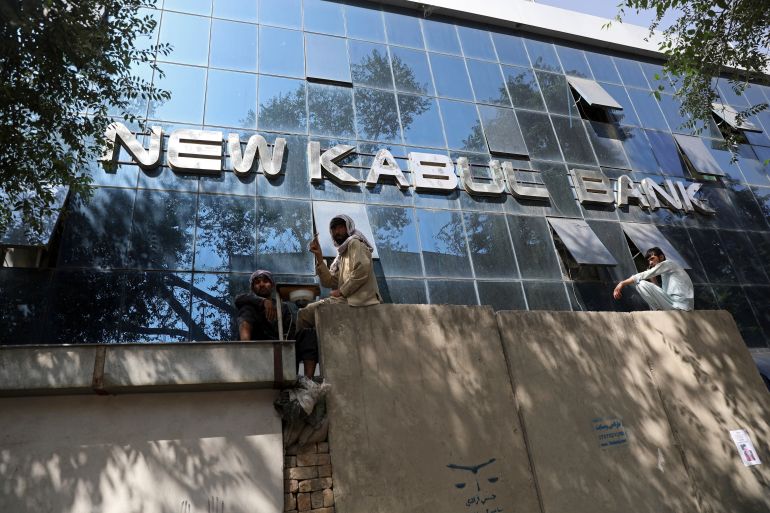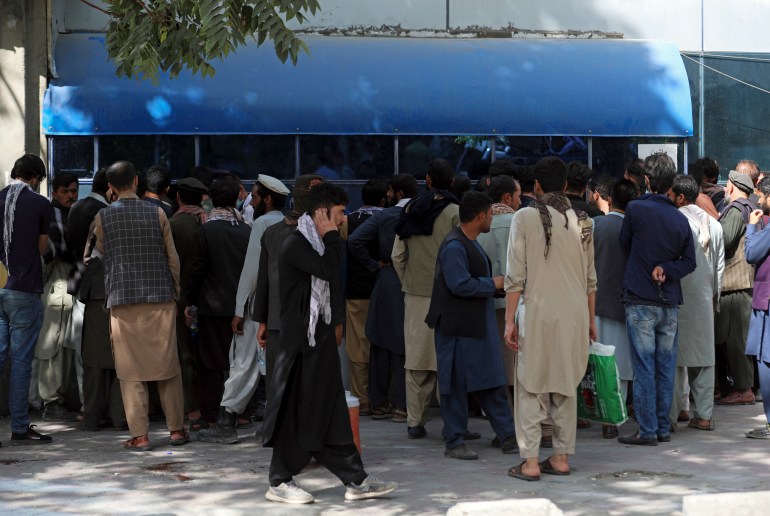What will happen to Afghanistan’s economy under Taliban rule?
The largest-ever allocation of the International Monetary Fund’s Special Drawing Rights is set to go into effect Monday, including an estimated $460m in SDRs for Afghanistan, but the Taliban is currently blocked from accessing it.

Afghanistan is set to receive nearly half a billion dollars from the International Monetary Fund (IMF) next week, but it’s unlikely the Taliban will be able to touch any of it.
The largest-ever allocation of IMF Special Drawing Rights (SDRs), equivalent to $650bn, is set to go into effect Monday, including an estimated $460m in SDRs for Afghanistan. But the IMF has pressed pause on letting the Taliban exchange the SDRs for hard currency. Instead, Afghanistan joins countries like Myanmar and Venezuela who receive IMF assets but can’t utilise them.
Keep reading
list of 4 itemsWatchdog describes litany of US failures in Afghanistan mission
What does the future hold for Afghanistan?
China seeks stability in Afghanistan before economic dialogue
“As is always the case, the IMF is guided by the views of the international community,” IMF spokesperson Gerry Rice said in a statement Wednesday. “There is currently a lack of clarity within the international community regarding recognition of a government in Afghanistan, as a consequence of which the country cannot access the Special Drawing Rights (SDRs) or other IMF resources.”
Earlier this week, 18 members of the United States Congress urged US Treasury Secretary Janet Yellen in a letter (PDF) to make sure that “nearly half a billion dollars in unconditional liquidity” does not go “to a regime with a history of supporting terrorist actions against the United States and her allies”.
It’s just the latest development in efforts to keep Afghanistan’s assets out of Taliban hands. So what money does the group have access to, and what is the state of the Afghan economy? Here’s what you need to know.
What was the status of the Afghan economy before the Taliban took over?
Struggling. The country’s economy is “shaped by fragility and aid dependence,” according to the World Bank, with 75 percent of public spending funded by grants.
That aid was already set to decrease by around 20 percent from 2016-2020 levels this year after “several major donors provided only single-year pledges” during the 2020 Afghanistan Conference, “with future support made conditional upon the government achieving accelerated progress in efforts to combat corruption, reduce poverty, and advance ongoing peace talks,” the World Bank said.
Now, with the Taliban in charge, it’s uncertain whether any of those conditions will be met, potentially further reducing the foreign aid the country relies on — including in the form of SDRs.
What is an SDR, exactly?
An SDR is an international reserve asset created by the IMF from a basket of currencies including the US dollar, Japanese yen, Chinese yuan, the euro and the British pound.
While not an official currency itself, the SDR is like an artificial currency that IMF member states can exchange for freely usable hard currencies like US dollars.
Countries can exchange their SDRs for those freely usable currencies at a fixed exchange rate, which changes daily and is posted on the IMF’s website.
How many SDRs does Afghanistan currently have?
Just over 37 million, which is equivalent to about $52.5m, according to the latest SDR exchange rate. Monday’s allocation, however, will boost that number to 323.8 million SDRs, or just under $460m, according to the IMF.
What other assets does Afghanistan have?
Da Afghanistan Bank (DAB) – the country’s central bank – listed 784.6 billion afghanis ($10bn) in assets for the period ending June 21, according to its bank statement (PDF), including 102.7 billion ($1.3bn) in gold and 28.7 billion ($366m) in foreign currency cash reserves.
Are all of those assets held in Afghanistan?
No. Like many developing countries, Afghanistan holds some of its assets overseas, including in the US, where the Taliban is the subject of economic sanctions.
For example, the country had more than 101 billion afghanis ($1.3bn) worth of gold stored at the Federal Reserve Bank of New York at the end of 2020, according to an independent auditor’s report (PDF) prepared at the end of last year.
DAB’s acting governor, Ajmal Ahmady, tweeted a breakdown Wednesday of where the bank’s major reserves are held, confirming $7bn are with the US Federal Reserve, including $1.2bn in gold.
The major investment categories include the following assets (all figures in billions)
(1) Federal Reserve = $7.0
– U.S. bills/bonds: $3.1
– WB RAMP assets: $2.4
– Gold: $1.2
– Cash accounts: $0.3(2) International accounts = 1.3
(3) BIS = $0.7
— Ajmal Ahmady (@aahmady) August 18, 2021
So what happened to the money the Afghan central bank has in the US?
It’s currently frozen. The US confirmed it froze $9.5bn in assets DAB has in accounts with the Federal Reserve and other American financial institutions to keep the Taliban from accessing them.
Before Kabul fell, the US had also stopped shipments of dollars to the country, Ahmady tweeted as he fled the country earlier this week.
So can the Taliban access any of the central bank’s funds abroad?
Probably only a small amount. In a tweet Wednesday, Ahmady estimated “the accessible funds to the Taliban are perhaps 0.1-0.2% of Afghanistan’s total international reserves. Not much.”
“Without Treasury approval, it is also unlikely that any donors would support the Taliban Government,” he added.
Therefore, we can say the accessible funds to the Taliban are perhaps 0.1-0.2% of Afghanistan’s total international reserves. Not much
Without Treasury approval, it is also unlikely that any donors would support the Taliban Government. https://t.co/UTrkms6i42
— Ajmal Ahmady (@aahmady) August 18, 2021
What about assets held in Afghanistan?
The 2020 auditor’s report on the country’s central bank showed there were 12.5 million afghanis ($159,600) worth of gold bars and silver coins held in the bank’s vault inside Afghanistan’s presidential palace, which the Taliban now controls.
Also in the hands of the Taliban are around $362m in foreign currency cash holdings, which “consist almost entirely of US dollars and were held at the bank’s head offices and branches as well as the presidential palace,” Reuters news agency reported.
Does the Taliban have other sources of funds?
Yes — but not all of them are legal.
The Taliban has always relied on criminal activities to fund itself, “including drug trafficking and opium poppy production, extortion, kidnapping for ransom, mineral exploitation and revenues from tax collection in areas under Taliban control or influence”, according to a United Nations Security Council report published in June.
How much income does the Taliban itself have?
That’s a tough question to answer exactly, but the UN Security Council report estimates the group has an annual income of between $300m and $1.6bn annually.
The UN noted that “external financial support, including donations from wealthy individuals and a network of non-governmental charitable foundations, also account for a significant part of Taliban income.”
The group has also sought to exploit Afghanistan’s mineral wealth, and the UN reports that “profits from the mining sector earned the Taliban approximately $464 million” in 2020.

Where does the current economic situation leave the Afghan people?
In an increasingly precarious position. More than 47 percent of the country already lived below the poverty line in 2020, according to data from the Asian Development Bank, and 34.3 percent of people with jobs live on less than $1.90 per day.
Most households rely on the low-productivity agriculture sector for their income, and security issues, corruption and political instability have all held back private-sector development, leading Afghanistan to rank 173rd out of 190 countries in the World Bank’s 2020 Doing Business Survey.
Unemployment stood at 11.7 percent in 2020 pre-Taliban rule, before people began fleeing the country and some women were dismissed from their jobs.
Ahmady summarised the grim picture in a tweet Wednesday, predicting depreciating currency, surging inflation and rising food prices.
Therefore, my base case would be the following:
– Treasury freezes assets
– Taliban have to implement capital controls and limit dollar access
– Currency will depreciate
– Inflation will rise as currency pass through is very high
– This will hurt the poor as food prices increase— Ajmal Ahmady (@aahmady) August 18, 2021